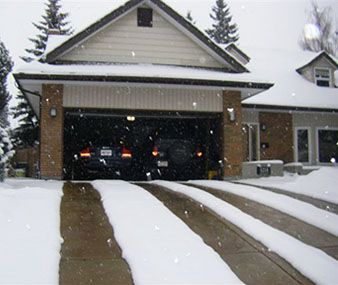Understanding the Power Requirements for a Heated Driveway
Are you looking to install a radiant heated driveway for your home or business? If so, one of the first questions you need to answer is whether you have the necessary power requirements. In most cases, having the power needed to run an efficient radiant snow melting system is not a problem. However, prior to any installation, customers must ensure that they do meet the power requirements for heating their driveways and or walks.

So, just how does one go about determining the power requirements for heating a specific area and how does one know whether the necessary power is available? First of all, you don’t have to figure this out by yourself. Warmzone’s experienced reps are happy to work with you to not only help you determine the necessary power requirements, but to design a system that best meets your specific snow melting and budget needs.
But homeowners should be aware of some basic guidelines when shopping for radiant heat. For example, one 30-amp breaker supplies enough power to heat a 170-square foot area. To heat a driveway of 350-square feet, two 30-amp breakers (or one 60-amp breaker) would be needed. Homeowners can check their home’s main breaker panel to see the power coming into the house. (Typical homes feature either two 100 amp panels or two 200 amp breakers. These are located at the top of the main breaker box, above the main breaker panel.) But the bottom line, in terms of power requirements, is that an electrician is ultimately the one to address all power issues. If you have questions about available power, talk with Warmzone as well as a qualified electrician to make certain there are no issues should you choose to move forward with the installation.
If you’re unsure of the square footage of your driveway, no worries; Warmzone can calculate that for you too. In most areas, using a special state-of-the-art technology, Warmzone can measure the area of your driveway while talking on the phone with you. Our helpful staff will work closely with you to ensure that the square footage of the area is measured correctly and the power requirements are therefore calculated properly.
Zoning Your Driveway Heating System
On rare occasions when there is insufficient power available to operate a large driveway heating system, the radiant heat system can be laid out in zones. Each zone is powered separately. As a storm first hits, zone 1 would power up and melt the snow in that area of the driveway. After zone 1, zone 2 would then activate to melt the snow in that area of the driveway. Click here for more detailed information about zoning your heated driveway.
Determining the Operating Cost of an Electric Heated Driveway
Homeowners are also keen to know the general operating costs of a heated driveway. Because radiant snow melting systems are specially designed for the specific demands of the average temperature and snowfall of their location, no two radiant heat systems are exactly alike. However, there is a formula that can be used to help you determine the approximate operating cost of a snow melting system.
General Guidelines to Determine a Heated Driveway’s Operating Cost
- Determine the total square footage of the area that will be heated. (The average American home has an 800 square foot driveway.)
- Multiply the square footage by the heat required (37 watts per sq. ft. for residential). This will give you a total for the watts per square footage required.
- Divide this number by 1,000 to convert to kilowatts.
- Look up the kilowatts-per-hour rate from the local power utility company.
- Multiply the kilowatts by the kilowatt rate. This gives you the cost-per-hour of usage for the snow melting system.
EXAMPLE for heating an 800 square foot driveway:
800 (sq.ft.) x 37 (watts) = 29,600 (total watts).
29,600 divided by 1,000 = 29.6 kw per hour. (This is what the power company will charge you per one hour of operation.) The average utility rate is .12 cents, therefore: 29.6 x .12 = $3.55. The cost of operation would be $3.55 per hour.
The operating cost of an automated snow melting system is typically less than that of hiring a professional snow removal service. And radiant heat can help to extend the life of concrete driveways and keeps them from being subjected to abrasive snow removal methods or harsh snowmelt chemicals or salt. Safety is particularly important for business owners who wish to avoid costly litigation due to personal injuries caused by slick ice. For more information on driveway heating systems, call Warmzone today at 888.488.9276.
Other helpful, informative web pages:
